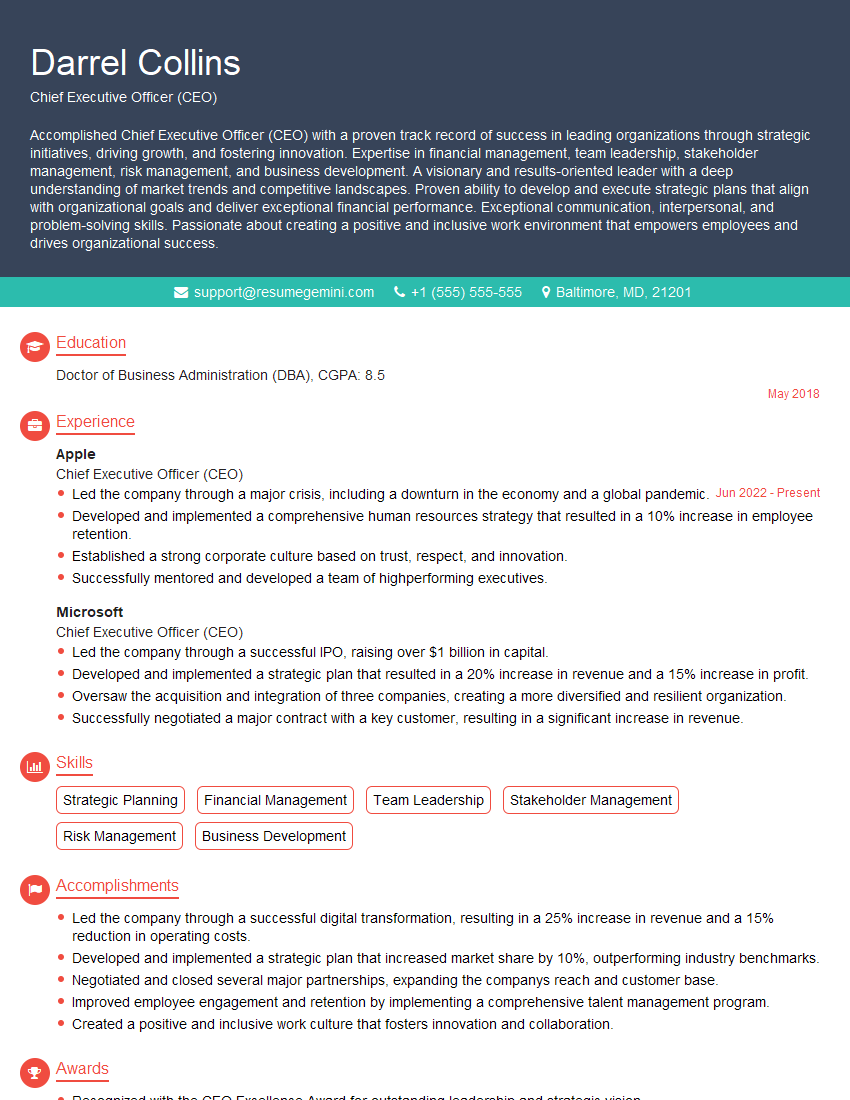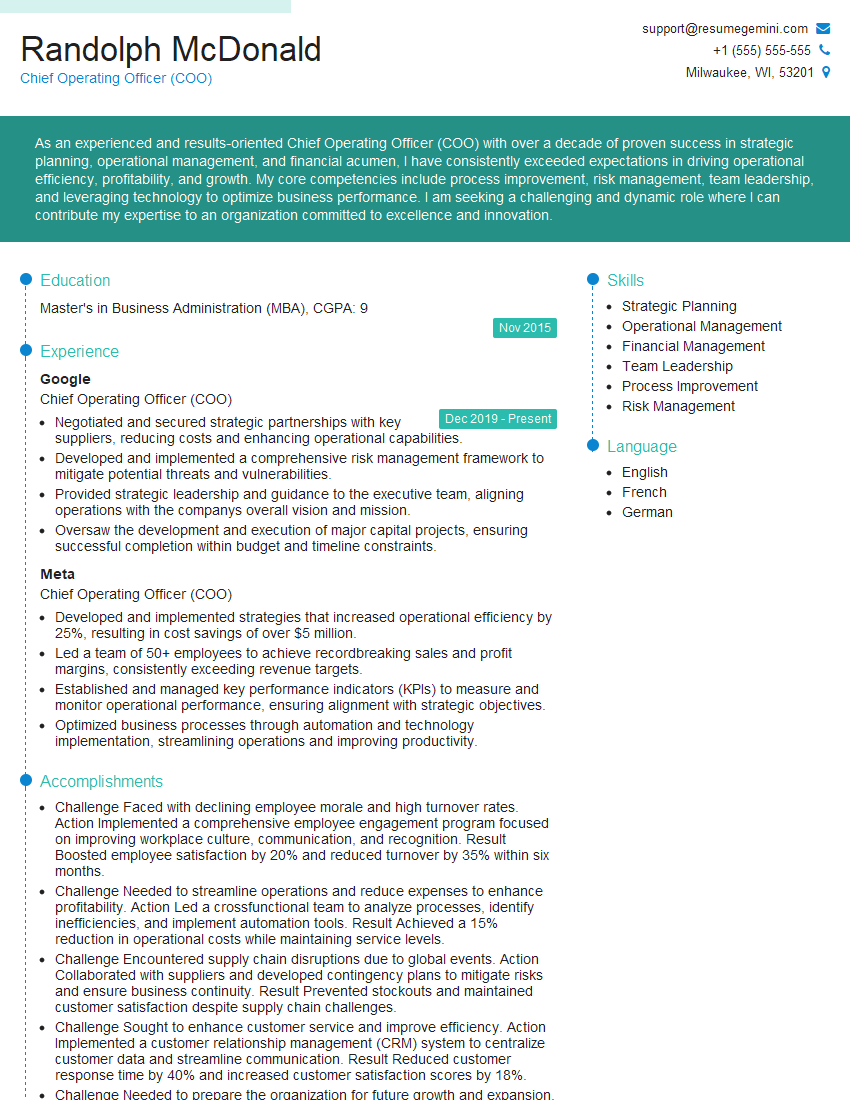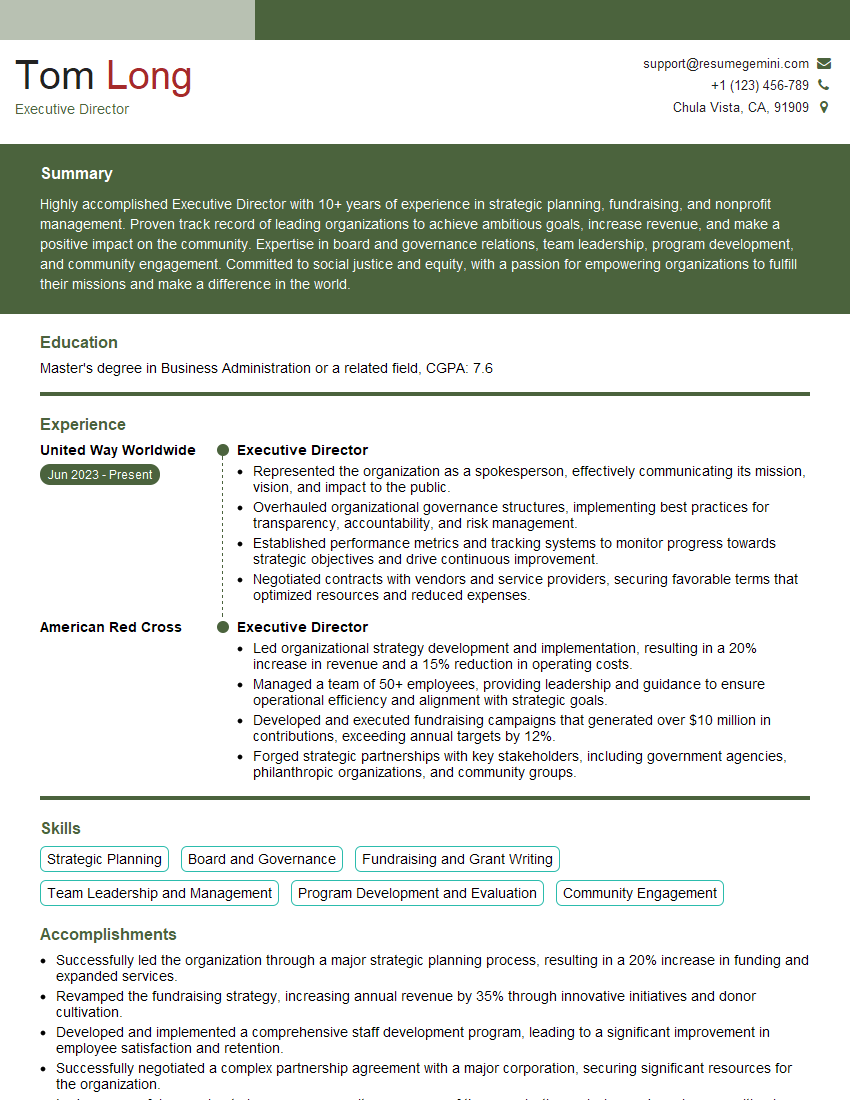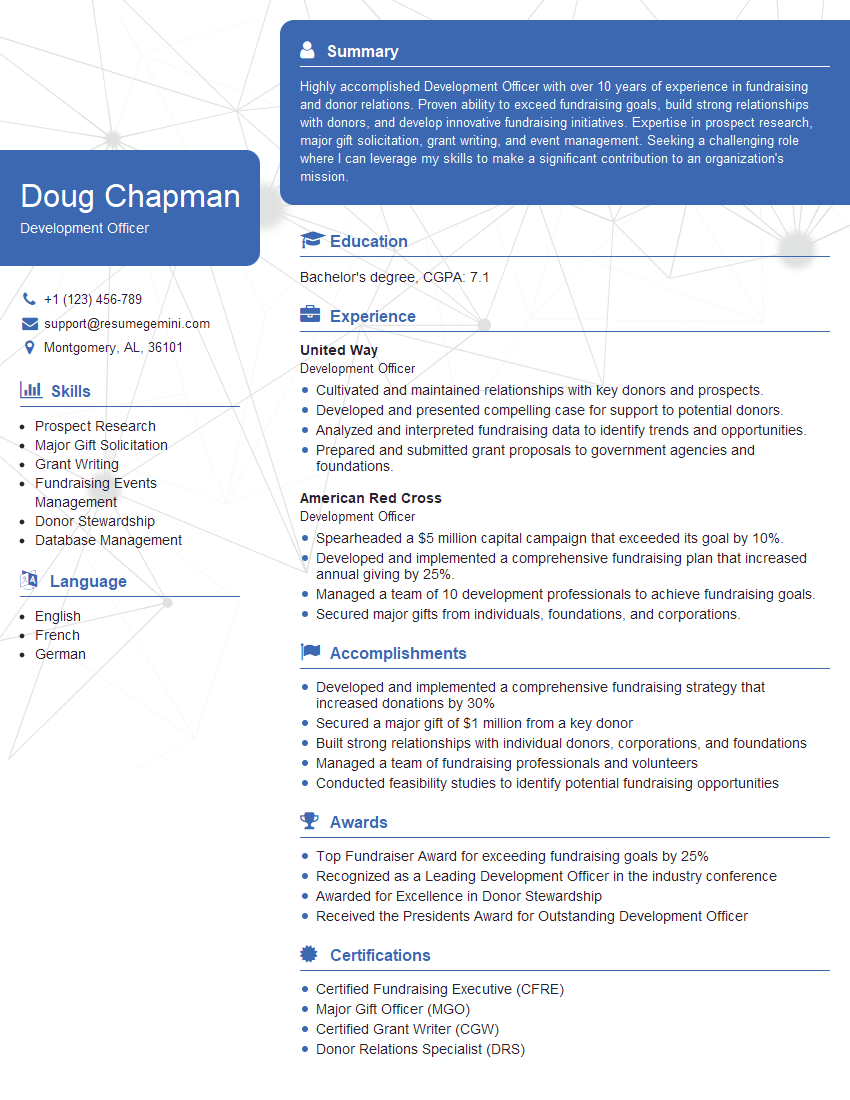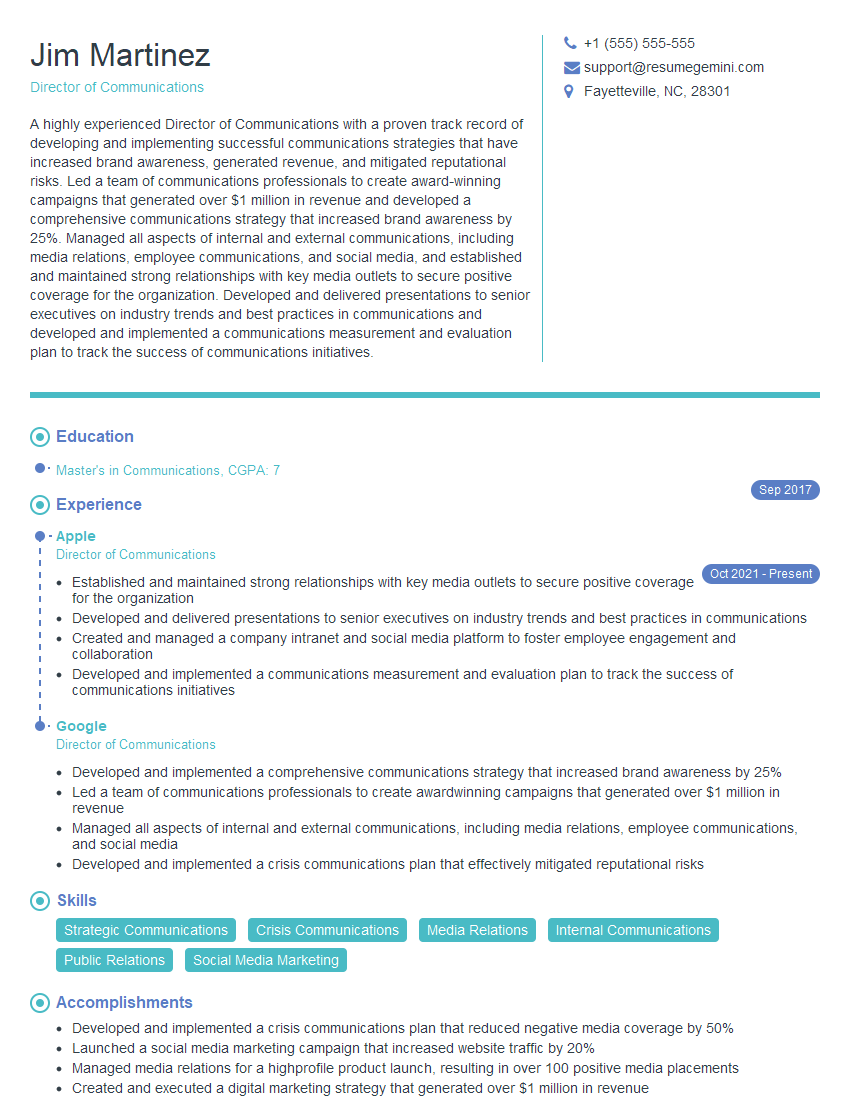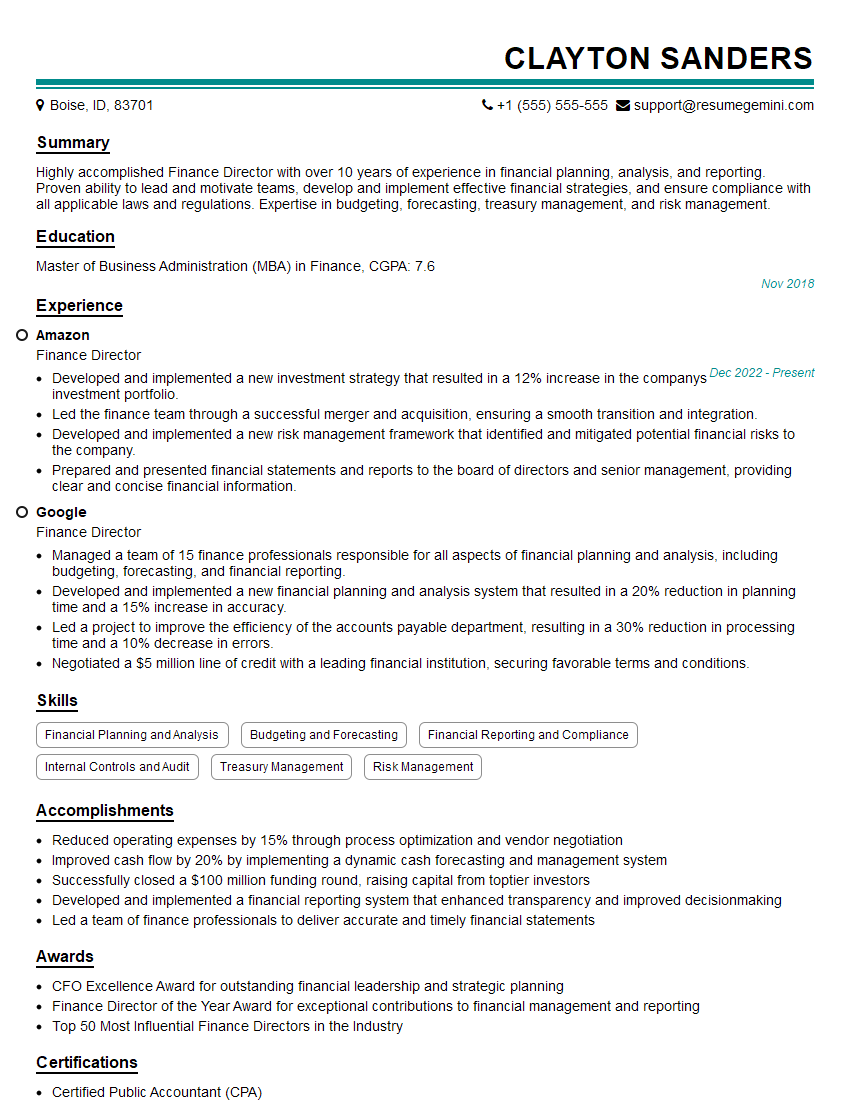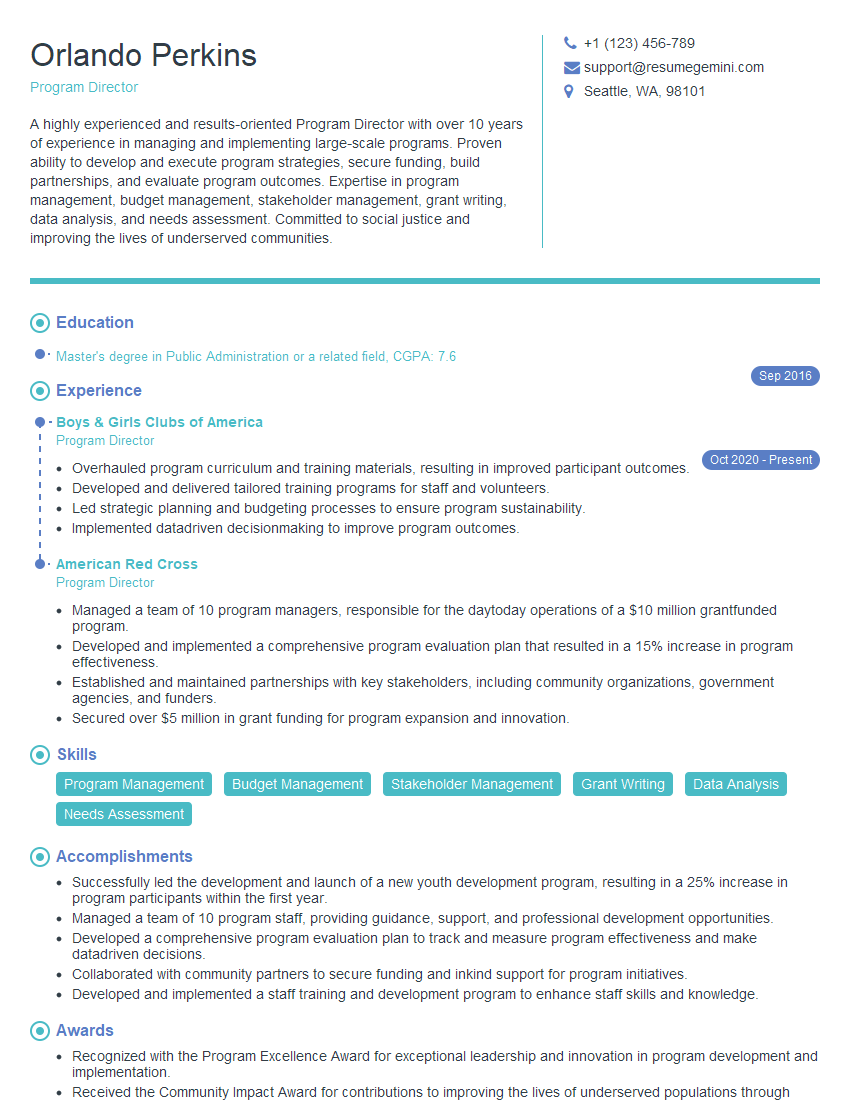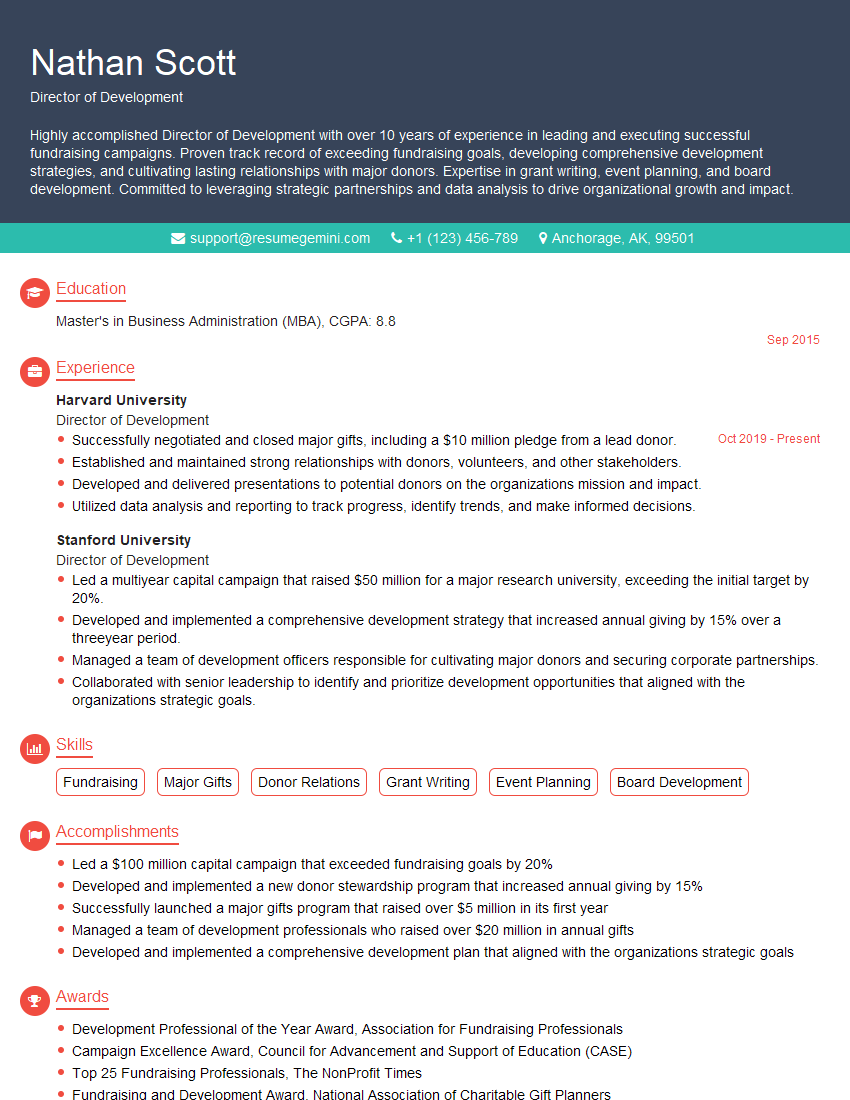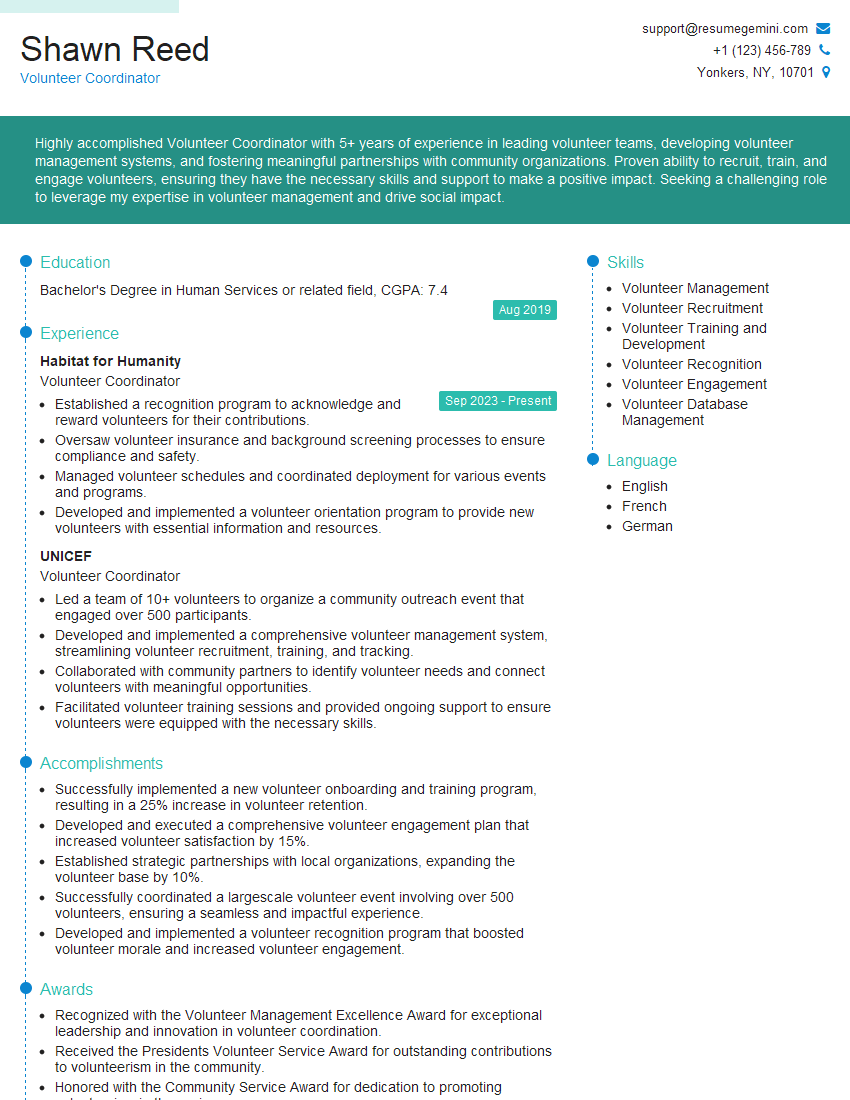Are you ready to stand out in your next interview? Understanding and preparing for Nonprofit Management and Board Development interview questions is a game-changer. In this blog, we’ve compiled key questions and expert advice to help you showcase your skills with confidence and precision. Let’s get started on your journey to acing the interview.
Questions Asked in Nonprofit Management and Board Development Interview
Q 1. Describe your experience in developing and managing a nonprofit budget.
Developing and managing a nonprofit budget requires a meticulous approach balancing resource allocation with mission fulfillment. It’s not just about numbers; it’s about strategic decision-making that ensures the organization’s long-term sustainability.
My experience involves creating comprehensive budgets encompassing projected revenue from various sources (grants, donations, fundraising events, program fees) and detailed expenditure plans for program activities, administrative costs, and fundraising efforts. This process starts with a thorough needs assessment, outlining program goals and the resources needed to achieve them. I then collaborate with program directors and staff to establish realistic budget lines and monitor expenditures throughout the fiscal year.
For example, at my previous organization, we implemented a zero-based budgeting system. This meant we started each budget cycle from scratch, justifying every expense. This ensured transparency and efficiency, identifying areas where we could potentially save resources and reallocate them to higher-priority initiatives. We also regularly tracked actual spending against the budget, producing variance reports that highlighted areas needing attention or adjustment. This allowed for proactive course correction, preventing potential overspending or shortfalls. Furthermore, I developed clear financial reporting mechanisms to communicate budgetary status to the board of directors and key stakeholders, ensuring accountability and transparency.
Q 2. How do you measure the success of a nonprofit program?
Measuring the success of a nonprofit program goes beyond simply tracking the number of people served. A robust evaluation framework requires a multi-faceted approach, using both quantitative and qualitative data to paint a comprehensive picture of impact.
- Quantitative Measures: These involve numerical data, such as the number of individuals served, program participation rates, changes in participants’ knowledge or skills (pre- and post-program assessments), and the cost per participant served. For example, a literacy program might track the number of students who improved their reading levels by a certain percentage.
- Qualitative Measures: These provide richer context by gathering feedback from participants, staff, and community partners. This might involve conducting surveys, focus groups, and individual interviews to assess program satisfaction, impact on participants’ lives, and the program’s overall effectiveness. For example, testimonials from program participants can illustrate the profound impact of the program on their lives.
A well-designed evaluation plan should also incorporate a logic model, which visually maps out the program’s activities, outputs, outcomes, and impact. This helps ensure that all evaluation activities align with the program’s overall goals. By employing both quantitative and qualitative methods, nonprofits can provide compelling evidence of their effectiveness and secure continued funding and support.
Q 3. Explain your approach to building relationships with major donors.
Building relationships with major donors requires a personalized and long-term approach. It’s not about a transactional exchange; it’s about cultivating genuine connections based on shared values and mutual trust.
My strategy focuses on:
- Identifying Potential Donors: This involves research to identify individuals or foundations whose philanthropic interests align with the organization’s mission. I use online databases, professional networks, and community contacts to build a prospect list.
- Personalized Communication: I avoid generic mass mailings. Instead, I craft personalized communication, demonstrating an understanding of the donor’s interests and motivations. This might involve tailored proposals, or simply sharing personal stories of how the organization’s work impacts the community.
- Cultivating Relationships: I regularly engage with potential donors through invitations to events, informational briefings, and personal meetings. This fosters trust and mutual understanding, making them feel valued and informed.
- Transparency and Accountability: I maintain open communication, providing regular updates on the impact of their donations. I demonstrate how their contributions are making a tangible difference, ensuring they feel a sense of partnership and ownership.
- Stewardship: Recognizing and thanking donors, however small or large their contribution is crucial to maintaining a positive relationship. A heartfelt thank you note, a personal phone call, or a special invitation to a program event all demonstrate gratitude and help to cultivate future giving.
For example, I once cultivated a relationship with a potential major donor by regularly sending them updates on a specific project they were interested in funding. This included photos, testimonials, and progress reports, keeping them engaged and reinforcing their decision to support our cause. This resulted in a significant multi-year commitment from the donor.
Q 4. What strategies do you employ to secure grants?
Securing grants requires a strategic and proactive approach that aligns the organization’s needs with the funder’s priorities. It’s a competitive landscape, so a well-crafted grant proposal is crucial.
My strategies include:
- Identifying Funding Opportunities: I use online databases (such as GrantWatch, Foundation Center, etc.) to identify grantmakers whose funding priorities align with our organization’s mission and programs.
- Developing Compelling Proposals: I craft proposals that clearly articulate the organization’s mission, program goals, and the need for funding. I emphasize the program’s potential impact and provide a detailed budget justifying the requested funds. I always ensure that proposals are tailored to each specific funder’s guidelines and requirements.
- Building Relationships with Grantmakers: I prioritize building relationships with grantmaking organizations by attending conferences, networking events, and proactively contacting program officers. This helps establish rapport and demonstrates a genuine interest in their work.
- Tracking and Following Up: I meticulously track all grant submissions and follow up with program officers, demonstrating persistent engagement and professionalism. This includes providing updates on project progress if requested.
- Reporting and Evaluation: I ensure timely and accurate reporting on grant projects, demonstrating accountability and responsible use of funds. This strengthens the organization’s reputation and increases the likelihood of receiving future funding from the same sources.
For instance, in one successful grant application, I carefully researched the funder’s past grants and tailored our proposal to specifically address their funding priorities. Our compelling narrative and clear budget led to a successful award.
Q 5. How would you handle a conflict between board members?
Handling conflicts between board members requires a diplomatic and structured approach that prioritizes the organization’s mission and the preservation of positive working relationships. My approach is based on principles of mediation and conflict resolution.
Steps I would take:
- Facilitate Open Communication: I would encourage the involved board members to express their perspectives in a safe and respectful environment. This might involve facilitating a private meeting with all parties involved.
- Identify the Root Cause: I would strive to understand the underlying causes of the conflict, which may be related to differing opinions, personality clashes, or procedural issues. Often, seemingly minor disagreements can stem from deeper, unaddressed concerns.
- Establish Common Ground: I would help the board members find common ground by focusing on their shared commitment to the organization’s mission. This involves finding areas of agreement and using them as a basis for resolving differences.
- Develop a Resolution Plan: Based on the identified root causes and common ground, I would work with the board members to develop a plan for resolving the conflict. This might involve agreeing on new procedures, clarifying roles and responsibilities, or seeking external mediation if necessary.
- Monitor and Follow Up: Following the resolution, I would monitor the situation to ensure the conflict doesn’t resurface. This involves maintaining open communication and checking in with the board members to ensure the agreed-upon plan is working effectively.
It is important to remember that conflict, when handled constructively, can lead to increased understanding, improved communication, and even strengthen the board’s effectiveness.
Q 6. Describe your experience with board recruitment and training.
Effective board recruitment and training are essential for a thriving nonprofit. My experience includes developing and implementing comprehensive strategies for attracting diverse and skilled board members and equipping them with the knowledge and skills to govern effectively.
My approach involves:
- Developing a Recruitment Plan: I create a plan that outlines the desired skills, experience, and demographics for new board members. This includes identifying potential candidates through networking, outreach to community leaders, and using online platforms.
- Candidate Selection: I establish a structured selection process that involves reviewing applications, conducting interviews, and checking references. This ensures that candidates have the necessary skills, commitment, and time to serve effectively.
- Orientation and Ongoing Training: I develop comprehensive orientation and ongoing training programs to equip board members with the knowledge and skills they need to fulfill their governance responsibilities. This might include workshops on nonprofit finance, strategic planning, fundraising, legal compliance, and board dynamics.
- Mentoring and Support: I offer ongoing support and mentoring to new board members, ensuring they feel welcomed, integrated, and equipped to handle their responsibilities. This can include pairing them with experienced board members who can provide guidance and support.
In one instance, I successfully recruited a diverse group of board members with skills in finance, marketing, and community outreach, significantly enhancing the board’s capacity. Regular training sessions ensured they were well-versed in their responsibilities, leading to more informed and effective decision-making.
Q 7. How do you ensure board member engagement and accountability?
Ensuring board member engagement and accountability is crucial for a high-performing board. My approach focuses on creating a collaborative and transparent environment where members feel valued, informed, and responsible for their roles.
Strategies I employ:
- Clearly Defined Roles and Responsibilities: I ensure that each board member understands their specific roles and responsibilities, including their contribution to committees and working groups. This minimizes confusion and maximizes effectiveness.
- Regular Board Meetings and Communication: I schedule regular board meetings that are well-organized and efficient. I also maintain open communication channels between meetings, using email, newsletters, or other tools to keep members informed and engaged.
- Strategic Planning and Goal Setting: I involve board members in the strategic planning process, ensuring they have a clear understanding of the organization’s goals and how their contributions support them. This fosters a sense of ownership and accountability.
- Performance Evaluations: I establish a system for regularly evaluating the board’s performance as a whole and individual board member contributions. This provides feedback and identifies areas for improvement.
- Committee Structure: Utilizing committees to delegate tasks empowers board members and promotes focused work. Regular committee reports to the full board keep everyone informed of progress and facilitate oversight.
- Utilizing Board Management Software: Technology such as board portals enhances communication and provides access to crucial information such as meeting agendas, minutes, and financial reports, making it more convenient for members to stay engaged.
For example, by establishing a regular system of committee reports and performance evaluations, I helped a previously disengaged board become more active and effective in its oversight and strategic decision-making.
Q 8. What is your experience with nonprofit strategic planning?
Nonprofit strategic planning is the process of defining a clear vision, setting measurable goals, and developing actionable strategies to achieve the organization’s mission. It’s essentially a roadmap for success. I’ve led and participated in numerous strategic planning processes, employing a participatory approach involving board members, staff, volunteers, and key stakeholders. This collaborative effort ensures buy-in and alignment across the organization.
My approach typically involves these key steps:
- Environmental Scan: Assessing the internal capabilities and external opportunities and threats facing the organization (SWOT analysis).
- Vision and Mission Refinement: Ensuring the organization’s core purpose is clearly articulated and relevant to the current context.
- Goal Setting: Establishing SMART (Specific, Measurable, Achievable, Relevant, Time-bound) goals aligned with the vision and mission.
- Strategy Development: Identifying the specific actions and initiatives required to achieve the goals.
- Implementation Plan: Detailing the resources, timelines, and responsibilities associated with each initiative.
- Monitoring and Evaluation: Establishing a system to track progress, measure outcomes, and make necessary adjustments.
For example, in my previous role at [Organization Name], we used a strategic planning process to successfully pivot the organization’s fundraising strategy, resulting in a 20% increase in donations within two years.
Q 9. How do you assess and manage risk within a nonprofit organization?
Risk management in a nonprofit is crucial for ensuring its sustainability and protecting its assets. It involves identifying potential threats, assessing their likelihood and impact, and developing strategies to mitigate those risks. My approach is proactive and comprehensive, focusing on both internal and external factors.
My process typically includes:
- Risk Identification: Brainstorming sessions with staff and board members to identify potential risks such as financial instability, regulatory changes, reputational damage, and security breaches.
- Risk Assessment: Evaluating the likelihood and potential impact of each identified risk. This often involves a qualitative or quantitative scoring system.
- Risk Response Planning: Developing strategies to mitigate risks, such as risk avoidance, risk reduction, risk transfer (insurance), and risk acceptance.
- Monitoring and Reporting: Regularly reviewing and updating the risk assessment and response plan, reporting progress to the board.
For example, to mitigate financial risk, we implemented a robust budgeting process and diversified our funding sources. To address reputational risk, we developed and implemented a comprehensive communications strategy to proactively manage our public image.
Q 10. How would you address a financial shortfall in a nonprofit?
Addressing a financial shortfall requires a swift, strategic response. Panic is the enemy of effective decision-making. I would first understand the root cause of the shortfall through a thorough review of the budget and financial statements. Then, I’d develop a multi-pronged approach:
- Cost Reduction: Identifying areas where expenses can be reduced without compromising the organization’s mission. This could involve renegotiating contracts, reducing staff travel, or streamlining operations.
- Increased Revenue Generation: Exploring new fundraising avenues, such as grant applications, major donor cultivation, corporate sponsorships, or crowdfunding campaigns.
- Restructuring Debts: If applicable, negotiating with creditors to extend payment terms or restructure loans.
- Emergency Funding: Seeking bridge loans from financial institutions or approaching foundations for emergency grants.
- Transparency and Communication: Keeping the board, staff, donors, and volunteers informed about the situation and the steps being taken to address it.
A real-world example: I once helped an organization facing a significant budget shortfall by securing a bridge loan and simultaneously launching a successful fundraising campaign targeting individual donors. The combination stabilized the finances and prevented major program cuts.
Q 11. Describe your experience with compliance regulations for nonprofits.
Compliance is paramount in the nonprofit sector. My experience encompasses navigating a range of regulations, including those related to tax exemption (IRS Form 990), financial reporting, fundraising regulations, and data privacy (GDPR, CCPA). I stay abreast of current regulations through professional development and collaborations with legal counsel.
My approach to compliance involves:
- Establishing robust internal controls: Implementing financial policies and procedures to ensure transparency and accuracy in financial reporting.
- Maintaining accurate records: Ensuring all financial records, donor information, and program data are meticulously maintained and securely stored.
- Regular audits and reviews: Conducting regular internal and external audits to ensure compliance with all applicable regulations.
- Training and education: Providing regular training to staff and board members on relevant compliance regulations and best practices.
- Seeking legal counsel: Consulting with legal professionals when needed to ensure the organization remains in compliance with the law.
For example, I successfully guided an organization through an IRS audit, ensuring a positive outcome and strengthening its internal controls for future compliance.
Q 12. How do you develop and implement a communication plan for a nonprofit?
A comprehensive communication plan is vital for a nonprofit’s success. It’s how you connect with your stakeholders, build relationships, and achieve your goals. My experience in developing and implementing these plans involves understanding the target audience, crafting compelling messages, and utilizing various communication channels.
Key components of my approach include:
- Audience Segmentation: Identifying key stakeholder groups (donors, volunteers, beneficiaries, media) and tailoring messaging to resonate with each.
- Message Development: Crafting clear, concise, and compelling messages aligned with the organization’s mission and goals.
- Channel Selection: Choosing appropriate communication channels, such as email marketing, social media, website, newsletters, press releases, and events.
- Content Calendar: Developing a content calendar to schedule and track the creation and distribution of communications.
- Measurement and Evaluation: Tracking key metrics such as website traffic, social media engagement, and donation levels to evaluate the effectiveness of the communication plan and make adjustments as needed.
For instance, I helped an organization develop a social media strategy that increased their follower base by 50% and drove a significant increase in online donations.
Q 13. How do you build and maintain relationships with stakeholders?
Building and maintaining strong relationships with stakeholders is fundamental to a nonprofit’s longevity and success. It requires consistent effort, clear communication, and mutual respect. I approach this through a combination of proactive engagement and responsive communication.
My strategies include:
- Regular Communication: Maintaining regular contact with stakeholders through newsletters, emails, reports, and personal interactions.
- Active Listening: Actively listening to stakeholder concerns and feedback, demonstrating a genuine interest in their perspectives.
- Transparency and Accountability: Being transparent about the organization’s finances, activities, and progress toward its goals.
- Relationship Building Events: Organizing events and opportunities for stakeholders to connect with the organization and each other.
- Feedback Mechanisms: Establishing clear channels for stakeholders to provide feedback and suggestions.
In a past role, I fostered strong relationships with major donors by providing regular updates on the impact of their contributions, leading to increased long-term giving.
Q 14. What is your experience with volunteer management?
Effective volunteer management is essential for maximizing the contributions of volunteers and ensuring a positive experience for them. I’ve overseen volunteer programs of varying sizes, always prioritizing recruitment, training, engagement, and recognition.
My approach includes:
- Recruitment and Onboarding: Developing effective recruitment strategies and a streamlined onboarding process to integrate volunteers smoothly.
- Training and Development: Providing comprehensive training to equip volunteers with the necessary skills and knowledge.
- Role Assignment and Supervision: Matching volunteers to roles that align with their skills and interests, providing clear expectations and ongoing supervision.
- Recognition and Appreciation: Regularly recognizing and appreciating the contributions of volunteers to boost morale and encourage retention.
- Communication and Feedback: Maintaining open communication with volunteers, gathering feedback, and addressing any concerns promptly.
In one instance, I implemented a new volunteer management system, resulting in a 25% increase in volunteer hours and improved volunteer satisfaction.
Q 15. How do you measure the impact of your nonprofit’s programs?
Measuring the impact of a nonprofit’s programs is crucial for demonstrating effectiveness and securing future funding. It involves a multi-faceted approach that goes beyond simply counting participants. We need to establish clear, measurable goals before program implementation. This involves defining specific, measurable, achievable, relevant, and time-bound (SMART) objectives. For example, if our program aims to improve literacy rates among at-risk youth, a SMART goal might be to increase average reading levels by 1 grade level within 6 months.
Then, we use various methods to collect data, such as pre- and post-program assessments, surveys, focus groups, and case studies. This data helps us quantify the changes brought about by the program. For the literacy program, we might use standardized reading tests before and after the intervention. Analyzing this data tells us if we’re meeting our goals.
Beyond quantitative data, we also gather qualitative data to understand the nuances of the impact. This might involve feedback from participants, testimonials, or observations from program staff. These insights provide a richer, more comprehensive understanding of the program’s effect. For instance, a participant’s testimonial about increased confidence and a newfound love of reading would add significant qualitative value.
Finally, we use this data to create a comprehensive impact report. This report clearly articulates our program’s successes, challenges, and lessons learned, and ultimately demonstrates the value of our work to funders and stakeholders.
Career Expert Tips:
- Ace those interviews! Prepare effectively by reviewing the Top 50 Most Common Interview Questions on ResumeGemini.
- Navigate your job search with confidence! Explore a wide range of Career Tips on ResumeGemini. Learn about common challenges and recommendations to overcome them.
- Craft the perfect resume! Master the Art of Resume Writing with ResumeGemini’s guide. Showcase your unique qualifications and achievements effectively.
- Don’t miss out on holiday savings! Build your dream resume with ResumeGemini’s ATS optimized templates.
Q 16. Describe your experience with fundraising events and campaigns.
My experience with fundraising encompasses a wide range of events and campaigns. I’ve successfully planned and executed everything from intimate donor dinners to large-scale galas, and from online crowdfunding campaigns to grant proposals.
For example, I spearheaded a fundraising gala that raised over $250,000 for a homeless shelter. This involved securing sponsorships, managing event logistics, creating engaging marketing materials, and cultivating relationships with potential attendees. The success of this gala was largely due to our meticulous planning and targeted marketing, which focused on communicating the impact of the shelter’s work.
In another instance, I developed a successful crowdfunding campaign that exceeded its goal by 20%. The key to this success was a compelling narrative that clearly articulated the need and the impact of the donations. We also used social media effectively to reach a wide audience and encourage sharing.
Throughout my experience, I’ve learned the importance of clear communication, strategic planning, and consistent follow-up. These are crucial for building relationships with donors and ensuring the success of any fundraising initiative.
Q 17. How do you cultivate relationships with potential donors?
Cultivating relationships with potential donors is a long-term investment that requires thoughtful planning and genuine engagement. It’s not just about asking for money; it’s about building trust and demonstrating the impact of the organization’s work.
I begin by identifying potential donors through research, networking, and referrals. This research might include examining philanthropic giving records, identifying individuals or corporations with a demonstrated interest in our mission, and exploring connections through existing board members or volunteers.
Once potential donors are identified, I initiate contact through personalized communication, such as a phone call or handwritten note, to introduce myself and the organization. I focus on building a relationship by sharing compelling stories, demonstrating transparency, and actively listening to their interests and concerns. This builds rapport and understanding.
I regularly invite potential donors to events or meetings to showcase our work and foster personal connections. I might also provide them with updates on our progress and invite them to participate in volunteer opportunities. This allows them to develop a deeper understanding of our mission and impact, leading to a stronger commitment.
Ultimately, cultivating these relationships is about demonstrating value and mutual respect. The goal is not immediate donations, but rather building a lasting partnership.
Q 18. What is your experience with donor stewardship?
Donor stewardship is the crucial process of nurturing relationships with existing donors to ensure their continued support. It’s about showing gratitude, demonstrating transparency, and keeping donors informed and engaged. It’s not just a post-donation task; it starts from the moment a donor first connects with the organization.
My approach involves timely and personalized acknowledgements of gifts, providing regular updates on how donations are being used, and offering opportunities for deeper engagement, such as donor visits, volunteer opportunities, or participation in exclusive events.
For example, after a major donation, I might send a handwritten thank-you note from the organization’s executive director and arrange a site visit so the donor can see firsthand the impact of their contribution. Regular updates could be provided through newsletters, emails, or progress reports, showcasing how the donation is contributing to achieving the organization’s goals.
Effective donor stewardship builds trust and strengthens the relationship, leading to increased loyalty and repeat donations. It recognizes that donors are partners in the organization’s mission and demonstrates a commitment to accountability and transparency.
Q 19. How do you ensure transparency and accountability in a nonprofit?
Transparency and accountability are fundamental to the success and credibility of any nonprofit. Ensuring these requires a multi-pronged strategy incorporating clear communication, robust financial management, and ethical practices.
Transparency starts with readily accessible information. This includes publishing a clear and concise annual report detailing financial performance, program activities, and impact. This report should be easily understandable to the average person, not just financial experts. We also make our IRS Form 990 publicly available.
Accountability involves establishing a strong internal control system to manage finances, track program outcomes, and ensure compliance with all regulations. This system should involve regular audits conducted by an independent third party. A clearly defined conflict of interest policy and adherence to ethical guidelines are also essential.
Open communication with stakeholders, including donors, volunteers, and the community, is critical. We actively solicit feedback, address concerns promptly, and provide regular updates on our activities and achievements. This two-way communication ensures our practices remain aligned with the community’s expectations and values. Transparency and accountability are vital for maintaining public trust and ensuring long-term sustainability.
Q 20. How do you manage conflict with stakeholders?
Conflict is inevitable in any organization, especially nonprofits where diverse stakeholders have varying perspectives and interests. My approach to conflict management involves proactive strategies and a focus on constructive dialogue.
I begin by fostering an environment of open communication and mutual respect. This means actively encouraging stakeholders to voice their concerns and perspectives without fear of retribution. It also means establishing clear channels for communication and conflict resolution.
When conflict arises, my focus is on understanding the underlying issues and needs of each party involved. I use active listening techniques to facilitate a collaborative discussion where all parties feel heard and understood. This helps to move away from blame and towards solutions.
If necessary, I employ mediation or facilitation techniques to help guide the discussion towards mutually acceptable outcomes. My aim is to find solutions that are fair, equitable, and sustainable, maintaining the working relationships and preserving the organization’s goals. Sometimes, formal conflict resolution processes may be required, depending on the nature and severity of the conflict.
Q 21. Describe your experience in developing and implementing a marketing plan for a nonprofit.
Developing and implementing a marketing plan for a nonprofit requires a deep understanding of the organization’s mission, target audience, and available resources. It’s about crafting a compelling narrative that resonates with potential donors, volunteers, and beneficiaries.
The first step involves conducting a thorough market analysis to understand the needs and preferences of the target audience. This informs the messaging and channels used to reach them. For example, a younger demographic might be reached more effectively through social media, while older generations might respond better to direct mail or print media.
Next, I define clear marketing goals, such as increasing awareness, attracting volunteers, or raising funds. These goals inform the strategy and tactics used in the marketing plan. This includes identifying key messages, developing marketing materials, and selecting the most effective communication channels.
The plan should outline specific strategies for each channel, including social media, email marketing, website content, and public relations. For example, a successful social media strategy would involve creating engaging content, actively participating in relevant conversations, and running targeted advertising campaigns. Regular monitoring and analysis of the results are crucial for evaluating the effectiveness of the marketing plan and making adjustments as needed. This iterative process ensures the plan stays relevant and achieves its objectives.
Q 22. What metrics do you use to track the success of your fundraising efforts?
Tracking the success of fundraising efforts requires a multifaceted approach, going beyond simply looking at the total dollars raised. We need to analyze various metrics to understand efficiency and impact.
- Return on Investment (ROI): This calculates the net profit (funds raised minus fundraising costs) divided by the total fundraising costs. A higher ROI indicates greater efficiency. For example, if a gala raised $100,000 but cost $20,000 to organize, the ROI is 400%.
- Donor Acquisition Cost (DAC): This tracks how much it costs to acquire a new donor. A lower DAC is desirable. We might track the cost of direct mail campaigns versus online advertising to determine which is more effective.
- Donor Retention Rate: This metric shows the percentage of donors who continue giving year over year. High retention demonstrates strong donor relationships and program impact. A 70% retention rate is generally considered strong.
- Average Gift Size: Tracking the average donation amount helps understand donor generosity and identify opportunities for cultivation. Growth in average gift size signals successful stewardship.
- Fundraising Efficiency Ratio: This looks at the percentage of funds raised that are actually used for programs, versus being spent on fundraising itself. A higher percentage dedicated to programs shows better fundraising efficiency. A ratio above 80% is often considered a positive indicator.
By tracking these metrics, we can make data-driven decisions to optimize fundraising strategies and improve overall performance. We regularly review these data points to understand what’s working and what needs adjustment.
Q 23. What is your experience with capacity building within a nonprofit?
Capacity building is crucial for nonprofit sustainability. It’s about strengthening the organization’s ability to achieve its mission. My experience encompasses several key areas:
- Board Development: I’ve facilitated board retreats focused on strategic planning, fundraising, and governance best practices, improving board effectiveness and engagement. This includes training board members on their fiduciary duties and helping them develop strategic goals.
- Staff Development: I’ve designed and implemented training programs for staff, focusing on areas like grant writing, financial management, and program evaluation. This can involve workshops, mentorship opportunities, and online learning platforms. For example, I once developed a grant-writing workshop that resulted in a 30% increase in successful grant applications.
- Volunteer Management: I’ve created robust systems for recruiting, training, and managing volunteers, ensuring their skills and time are used effectively to support program delivery. This includes clear volunteer roles, training materials, and ongoing communication.
- Technology Integration: I’ve assisted organizations in adopting new technologies to streamline operations and enhance impact. This might include implementing CRM systems to improve donor management or project management software for better task organization.
The key to successful capacity building is a needs assessment followed by a tailored plan that addresses specific weaknesses and builds on existing strengths. It’s an ongoing process, not a one-time event.
Q 24. How do you ensure the sustainability of a nonprofit program?
Ensuring program sustainability requires a holistic approach that considers financial, operational, and programmatic factors.
- Diversified Funding Streams: Reliance on a single funding source is risky. A sustainable program cultivates multiple funding streams, such as grants, individual donations, corporate sponsorships, and earned income (e.g., program fees).
- Effective Program Evaluation: Regularly assess program impact using clear metrics. This demonstrates value to funders and stakeholders, justifying continued support. For example, tracking the number of individuals served and changes in their outcomes provides strong evidence of a program’s effectiveness.
- Strong Partnerships: Collaboration with other organizations can expand reach, share resources, and enhance program impact. Partnerships can also reduce operational costs and increase efficiency.
- Financial Management: Maintain sound financial practices, including budgeting, expense tracking, and financial reporting. This fosters accountability and builds trust with donors and stakeholders. Regular financial reviews and audits help to ensure that the nonprofit is financially stable.
- Community Engagement: Deep community engagement builds long-term support and ensures the program remains relevant and responsive to community needs.
Sustainability isn’t a destination; it’s a continuous journey requiring proactive planning, evaluation, and adaptation.
Q 25. Describe your experience with data analysis and reporting in a nonprofit context.
Data analysis and reporting are critical for effective nonprofit management. My experience involves:
- Data Collection: Implementing systems to collect accurate and reliable data on various aspects of the organization’s work, including program participation, fundraising results, and donor information. This often involves using database software to track data.
- Data Analysis: Utilizing data analysis techniques to identify trends, measure program effectiveness, and inform decision-making. This might involve calculating key performance indicators (KPIs) and creating visualizations such as charts and graphs to present the findings.
- Report Writing: Producing clear, concise, and compelling reports to communicate findings to stakeholders, including donors, board members, and staff. These reports need to be tailored to the audience and present the data in a user-friendly format.
- Software Proficiency: I’m proficient in using data analysis software, such as Excel, and database management systems. I am also experienced with data visualization tools like Tableau, which help to present findings more effectively.
For instance, I once used data analysis to demonstrate the impact of a youth mentorship program, showing a significant improvement in participants’ academic performance and reduced rates of delinquency. This data-driven approach secured increased funding for the program.
Q 26. How do you effectively delegate tasks and manage a team in a nonprofit setting?
Effective delegation and team management in a nonprofit setting require trust, clear communication, and a focus on empowerment.
- Clear Expectations: I establish clear roles and responsibilities, providing detailed instructions and setting realistic deadlines for each task. I also ensure that team members understand the bigger picture and how their work contributes to the overall mission.
- Empowerment: I empower team members by providing them with the authority and resources they need to succeed. I encourage initiative and creative problem-solving, fostering a collaborative environment.
- Regular Communication: I maintain open and regular communication with my team through meetings, emails, and one-on-one check-ins. I encourage feedback and address concerns promptly.
- Recognition and Appreciation: I acknowledge and appreciate team members’ contributions, both big and small. Celebrating successes helps to build morale and team cohesion.
- Skill-Based Delegation: I delegate tasks based on team members’ individual strengths and skills, ensuring efficient workflow and maximum impact.
Delegation isn’t about dumping work; it’s about strategically distributing tasks to optimize team performance and develop individual capacity. It requires trust, support, and effective follow-up.
Q 27. What is your experience working with diverse populations?
Working with diverse populations is fundamental to effective nonprofit work. My experience involves understanding and respecting cultural differences, promoting inclusivity, and ensuring equitable access to services.
- Cultural Competency Training: I’ve participated in and facilitated cultural competency training programs, promoting understanding of diverse perspectives and communication styles.
- Inclusive Program Design: I’ve designed and implemented programs that are accessible and relevant to people from diverse backgrounds, considering factors such as language, cultural norms, and physical limitations. For example, I once helped develop a bilingual outreach program that significantly increased participation among the Hispanic community.
- Community Engagement: I’ve engaged with diverse communities through outreach efforts, building relationships and fostering trust. This can involve attending community events, partnering with community leaders, and seeking input from diverse stakeholders when designing programs.
- Equity and Inclusion Policies: I’ve supported the development and implementation of equity and inclusion policies within organizations to ensure fair and equitable access to resources and opportunities for all.
Working with diverse populations requires empathy, humility, and a genuine commitment to creating an inclusive environment where everyone feels valued and respected.
Q 28. How do you prioritize competing demands and manage your time effectively?
Prioritizing competing demands and managing time effectively is crucial in the fast-paced world of nonprofit management. I use a combination of strategies:
- Prioritization Matrix: I use a prioritization matrix (like an Eisenhower Matrix – Urgent/Important) to categorize tasks based on urgency and importance. This helps me focus on high-impact activities first.
- Time Blocking: I allocate specific time blocks for particular tasks, ensuring dedicated focus and minimizing distractions. For example, I might block out two hours each morning for focused writing, preventing it from getting delayed by other tasks.
- Delegation: I strategically delegate tasks to others on the team when possible, freeing up my time for higher-level strategic work.
- Goal Setting: I establish clear, measurable, achievable, relevant, and time-bound (SMART) goals, creating a roadmap for my work and helping to stay focused.
- Regular Review: I review my progress regularly, adjusting my schedule and priorities as needed. This adaptive approach ensures I’m always working on what’s most critical.
Time management is a skill that requires constant practice and refinement. The key is to be proactive, organized, and flexible in adapting to changing priorities.
Key Topics to Learn for Nonprofit Management and Board Development Interview
- Strategic Planning & Fundraising: Understanding the development and implementation of strategic plans, including budgeting, resource allocation, and diverse fundraising strategies (e.g., grants, individual giving, corporate sponsorships).
- Board Governance & Leadership: Knowledge of best practices in board governance, including roles and responsibilities of board members, effective meeting management, and fostering a collaborative board culture. Practical application includes demonstrating understanding of Robert’s Rules of Order and conflict resolution techniques within a board setting.
- Nonprofit Financial Management: Proficiency in understanding nonprofit accounting principles, budget development and monitoring, financial reporting, and donor stewardship. This includes the ability to analyze financial statements and identify areas for improvement.
- Program Evaluation & Impact Measurement: Experience with designing and implementing program evaluations to assess effectiveness, track progress towards goals, and demonstrate impact to stakeholders. This involves understanding different evaluation methodologies and data analysis techniques.
- Risk Management & Compliance: Understanding and applying principles of risk management within a nonprofit context, including legal compliance, ethical considerations, and internal controls. This includes familiarity with relevant regulations and best practices.
- Volunteer Management & Engagement: Knowledge of effective strategies for recruiting, training, and managing volunteers, fostering their engagement and maximizing their contributions to the organization.
- Stakeholder Engagement & Communication: Ability to effectively communicate with diverse stakeholders (board members, donors, staff, volunteers, beneficiaries) and build strong relationships. This includes developing and implementing effective communication plans.
Next Steps
Mastering Nonprofit Management and Board Development is crucial for a successful and rewarding career in the nonprofit sector. It demonstrates a commitment to mission-driven work and opens doors to leadership roles with significant impact. To maximize your job prospects, it’s vital to create an ATS-friendly resume that highlights your skills and experience effectively. ResumeGemini is a trusted resource to help you build a professional and compelling resume that showcases your unique qualifications. Examples of resumes tailored to Nonprofit Management and Board Development are available to guide you through the process.
Explore more articles
Users Rating of Our Blogs
Share Your Experience
We value your feedback! Please rate our content and share your thoughts (optional).
What Readers Say About Our Blog
Hello,
We found issues with your domain’s email setup that may be sending your messages to spam or blocking them completely. InboxShield Mini shows you how to fix it in minutes — no tech skills required.
Scan your domain now for details: https://inboxshield-mini.com/
— Adam @ InboxShield Mini
Reply STOP to unsubscribe
Hi, are you owner of interviewgemini.com? What if I told you I could help you find extra time in your schedule, reconnect with leads you didn’t even realize you missed, and bring in more “I want to work with you” conversations, without increasing your ad spend or hiring a full-time employee?
All with a flexible, budget-friendly service that could easily pay for itself. Sounds good?
Would it be nice to jump on a quick 10-minute call so I can show you exactly how we make this work?
Best,
Hapei
Marketing Director
Hey, I know you’re the owner of interviewgemini.com. I’ll be quick.
Fundraising for your business is tough and time-consuming. We make it easier by guaranteeing two private investor meetings each month, for six months. No demos, no pitch events – just direct introductions to active investors matched to your startup.
If youR17;re raising, this could help you build real momentum. Want me to send more info?
Hi, I represent an SEO company that specialises in getting you AI citations and higher rankings on Google. I’d like to offer you a 100% free SEO audit for your website. Would you be interested?
Hi, I represent an SEO company that specialises in getting you AI citations and higher rankings on Google. I’d like to offer you a 100% free SEO audit for your website. Would you be interested?
good
